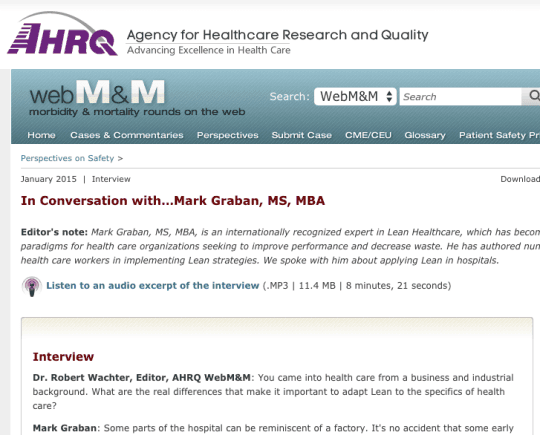I'm honored to have been interviewed by Dr. Robert Wachter for his “Web M&M” interview series on the AHRQ website.
In Conversation with…Mark Graban, MS, MBA
Dr. Wachter is a leader in the patient safety movement who I've respected and admired for quite a while. You can read his “Wachter's World” blog and his book Understanding Patient Safety is very influential and a must-read. I've also had a chance to read an advance copy of his upcoming book The Digital Doctor: Hope, Hype, and Harm at the Dawn of Medicine's Computer Age, which I'm enjoying very much. I'll be doing a podcast interview with Dr. Wachter in a few weeks.
Update: Here is the podcast.
See my post from 2009 that discusses (and links to) a blog post and an article that he wrote on finding the right balance between blame and accountability: “No Blame” Doesn't Mean “No Accountability”
Click here or on the image below to read the interview.
Part of the interview:
MG: Lean is very, very different than that traditional top-down–what's often called command-and-control–management model. Lean has a much more participatory approach. Toyota talks about one of their core pillars being the idea of “respect for people” and realizing that everybody in an organization–regardless of their level of formal education, the size of their paycheck, and the number of letters after their name–has an important role to play. We can respect that role they play as part of a team. Everybody has ideas to bring forward about improving their own work. Everybody can point out problems. When an organization listens to those people and then helps them fix things, these are the cultural themes that lead to improved safety and improved quality in a factory or in an operating room. John Shook from the Lean Enterprise Institute spent many years at Toyota. He was the first American to work for Toyota in a management role, and he said it's both top-down and bottom-up. He would say it's not laissez-faire management or “do whatever you want as long as you get results, I don't care.” It's focused on the process and the results. The top-down role that leaders still have is to help define strategy, set direction, and define what the organization needs to do and why. That's a critically important role.
I'm curious to hear what you think. Leave a comment here on the post, since you can't comment on the AHRQ site.
Please scroll down (or click) to post a comment. Connect with me on LinkedIn.
Let’s work together to build a culture of continuous improvement and psychological safety. If you're a leader looking to create lasting change—not just projects—I help organizations:
- Engage people at all levels in sustainable improvement
- Shift from fear of mistakes to learning from them
- Apply Lean thinking in practical, people-centered ways
Interested in coaching or a keynote talk? Let’s start a conversation.











From the interview: ‘We don’t just delegate and dump everything on the frontline staff and say, “This is Lean, you’re empowered, go do it.”‘
I’m not sure how prevalent it is exactly but the misconception that Lean (or more specifically, CI) is a bottom-up exercise, seems to be alive and well here in Australia. You re-iterated Deming’s point that most problems are part of the system; he also repeatedly stressed that these often things workers can’t do anything about. Investment in new equipment, changes in other parts of the organisation, negotiation with suppliers, are just some of the things that management needs to step-in and help with.
Also, if ’empowerment’ is just rhetoric to push accountability downwards then we’ve got other problems…
As John Shook from LEI says, Lean is both top-down and bottom-up.
it’s top-down in the sense that senior leaders primarily set direction (with “catchball” input from those below them). And it’s bottom-up that ideas tend to come from the employees.
But, there has to be alignment. Leaders have to lead. Senior leaders are responsible for the system, the culture, the environment, etc.
Agreed. A change in leadership thinking is essential. What I sometimes see, and have been involved in before I “got it”, are attempts to “inject” improvement skills into individual work teams. Needless to say, I quickly learnt why that doesn’t stick.